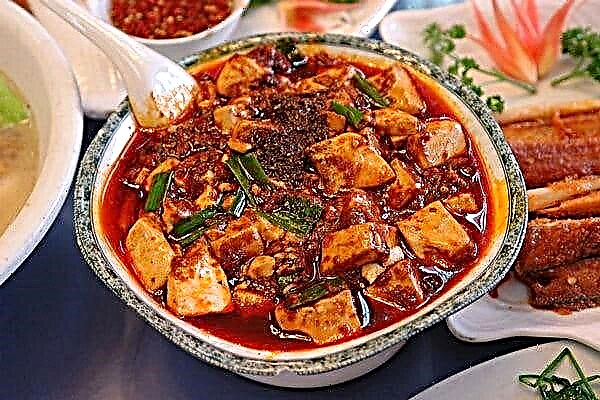Chinese cuisine is popular in many countries of the world, it is an integral part of the culture of the Middle Kingdom. The speed of its spread is explained by the affordable price and the possibility of cooking without using a classic oven and oven.
Story
Food in China includes many local animals and plants. But since the beginning of agriculture, cereals have been the basis of the diet, and meat products occupy a small part of it. In the old days, chefs enjoyed the same status as important officials.

During the Zhu and Shang dynasties, meat products were dried, salted and pickled. The first cereals were rice and millet; a little later, wheat and barley came into use. Fruit was used constantly, and from the Mongols, the Chinese learned to stew and fry.
Important! The first folk cookbook was created by the artist Ni Zang. It described in detail how to use shellfish, chicken, mushrooms, non-alcoholic and alcoholic drinks, and their names were also mentioned.
Regional cuisines
Dishes in Chinese cuisine are prepared according to regional divisions. The nuances are related to climatic conditions, lifestyle and provincial history. On the islands (Hainan, etc.), tourists meet more fish dishes, in other parts - grain and meat.
Cantonese cuisine
Regional Chinese food has become famous not only in the country, but also abroad. It is customary to eat almost all local meat species there, including snakes, snails and their internal organs. The exception is goat and lamb.
The list of light snacks includes real dim sum (small sizes), its varieties are presented:
- daikon pies;
- rolls with rice noodles;
- Jiaozi dumplings;
- leafy vegetables;
- cereals;
- broths.

Important! Classic Cantonese breakfast includes dim sum and yamcha tea.
You May Also Like
Sichuan cuisine
Differs in bright taste, spicy and spicy dishes, due to the use of red and local peppers, garlic, sesame paste, ginseng and nuts in cooking.
Famous representatives include:
- mapo tofu;
- Chicken Gongbao;
- Sichuan style pork stew;
- fish-flavored pork;
- noodles.
Important! Not all Chinese dishes, especially this variety, are perceived positively by foreigners.
Anhui cuisine
The diet is based on a large amount of local herbs and vegetables, a small amount of seafood.
It resembles the cuisine of Jiangsu; the famous dishes include the product made from mushrooms and bamboo.
Shandong cuisine
Known in the north of the country, famous for the use of cereals, seafood and various culinary techniques. Famous dishes include:
- roast duck;
- scalded lamb;
- carp in sweet and sour sauce;
- stewed abalone and sea cucumber;
- famous vinegars.

Important! Local chefs are great at preparing corn, which grows starchy and tough in the area.
Fujian cuisine
You May Also Like
She was greatly influenced by Japanese traditions. It uses mushrooms, bamboo shoots, uses different cutting options, which gives them a special texture, taste and aroma.
Fujian cuisine is famous for a variety of broths and dishes with gravy, cooking masterpieces by stewing, boiling in water or steaming.
Jiangsu cuisine
It is famous for its delicate taste, composition, selected strictly according to the season. Chefs pay a lot of attention to color matching and flavoring. The cuisine is known outside the country and very popular, the list of common dishes is presented:
- pickled duck;
- crystal pork legs;
- fried eel with a crust;
- Yangzhou dried stripes.
Important! Travelers are interested in "lion heads" from the Chinese national cuisine. These are meatballs made from pork and crab shell powder.
Hunan cuisine
The pungency of this variety is associated with garlic, peppers and onions. Differs in simple flavors and reduced fat content.
Dishes are processed by smoking, stewing and roasting, smoked meats and dried ingredients are often used. Famous dishes are steamed herring and squirrel carp.
Zhejiang cuisine
It is famous for its moderate aroma, freshness and tenderness. Common dishes include sour lake fish, Longjing shrimp, lotus root powder and zongzi in lotus leaves with pork.

Important! Chinese cuisine in Shanghai is not a new regional subtype. It consists of a mixture of culinary traditions collected from all over the country. It includes the culinary delights of all provinces, the standard breakfast includes rice broth along with meat or fish pieces and vegetables.
Staple foods
In classical Chinese cuisine, it is customary to use:
- Rice - boiled or fried. In addition to the main dishes, it is used in the preparation of vinegars and alcoholic beverages.
- Chinese noodles are distinguished by their size, texture, composition and shape. For lunch, it is served cold, hot or dry, with or without additives, sauces.
- Soy is the main source of protein in the diet. Used in the form of soy milk, paste, butter, tofu.
- Vegetables - Commonly used vegetables include cabbage, broccoli, bean sprouts, pea stalks, and mustard leaves. Some people prefer celery, bitter cucumbers, and watercress.
- Meat and seafood - the register includes pork, chicken, duck, pigeon, beef. Eggs, shark fins, abalone and other seafood are used for cooking.
- Seasonings - Common uses are garlic, ginger, green onions, sesame oil, white pepper, cinnamon, dill, cloves, and coriander. To give a certain shade to the dishes add tangerine zest, mushrooms, shrimp fry - only dried.
- Sauces - preference is given to soy, rice, oyster, fish, etc.

Important! The national dishes of China include dog meat; modern residents eat it on the days of the summer solstice. The tradition appeared 500 years ago, which involves cooking stews and broths.
Soups
The way they are created depends on the region, most of them are drinkable. There are five subspecies of broths:
- transparent - with ham and chicken;
- chicken is the basis for most local dishes;
- pork - requires long cooking;
- white - made from pig bones;
- fish - fried ingredients are used for cooking, then it is boiled for several hours.
Important! The ingredients used in the process can be reused. The broth is called the "second soup".
Desserts
Sweet dishes include:
- ficus and herbal jelly;
- rice cakes and cakes;
- candy;
- ice shavings with syrup;
- ice cream;
- seasonal fresh fruits.

Important! Delicious pastries are served raw, baked, fried, boiled.
Beverages
The Chinese menu is characterized by tea, milk, or regular warmed water. The latter is used for warming in winter or cooling in summer heat.
Tea
A Chinese drink necessarily goes with snacks, which include:
- nuts;
- dried fruits;
- sweets;
- melon seeds;
- berries.
The country was the first to start drinking and growing tea. It was accessible to people of all social levels.
Important! Herbal teas are made from dried leaves, flowers, grains, and seeds.
Milk
Dairy products are not very common - the problem is associated with the low efficiency of animal husbandry in the country.Some of the indigenous inhabitants have congenital lactose intolerance.
Important! Only in the 20th century (with the arrival of Western food) the situation changed slightly, and the locals stopped avoiding milk.
Alcoholic drinks
Alcoholic drinks have been produced in the country since ancient times. Common ones include:
- fermented yellow wine (10-15% alcohol) - from rice;
- miju — rice wine reminiscent of sake;
- baijiu - filtered white wine (60 degrees of alcohol).

Alcoholic snake liqueurs and beer are common in Beijing and throughout the country.
Etiquette
The norms of behavior are slightly different from the traditional ones:
- during the meal, the chefs and their skills are sure to be praised;
- when visiting a public institution, the payment for the entire table is made by the one who is given the only menu;
- champing or other loud sounds are not prohibited when eating;
- fallen pieces from the floor are not lifted.
A number of prohibitions and conditions apply to chopsticks:
- when taking food from a common dish, the fence is carried out with separate devices or with the help of their own, but inverted with thick ends;
- you cannot transfer food with chopsticks or stick them vertically into rice;
- if meat is served on the bones, then it is eaten only with the help of the device, and not with the hands;
- they do not wave chopsticks and do not indicate anything with them;
- the solid parts of the broth are removed with a device, and the liquid parts are consumed with a spoon;
- after the end of the meal, the sticks are laid out on special supplies or left on the edge of the plate.
Important! Sticks can be made of plastic, bamboo, or wood.
Popularization in the West
The massive migration of the indigenous population to America during the Sino-Japanese War led to the penetration of typical cuisine to many continents. After the end of World War II, resettlement became even more active, which served as the spread of Chinese national habits.
During this period, fast food began to develop, and the sale of street food in China was carried out in boxes, which allowed it to become widespread in other countries. Its advantages included the cleanliness and safety of the packaging, the ability to heat and transport food (bought on the street), and keeping it warm for a certain period of time.

Later, Chinese restaurants were opened, and by the end of the 20th century, representatives of the Middle Kingdom began to actively populate Europe. A variety of cafes and fast food delivery services have appeared in it.
Chinese cuisine at home: what traditional dishes can you cook at home
For exotic lovers, the chefs offer to try simple homemade dishes:
- seafood noodles;
- pork in Chinese;
- Peking duck or chicken;
- vegetable stew with cabbage and zucchini.
Chinese cooking is a whole science that can take several decades to comprehend. The secrets of cooking and recipes for warm, cold or dessert dishes are kept secret by many masters and you can get to know them only in individual restaurants, and not at home.











